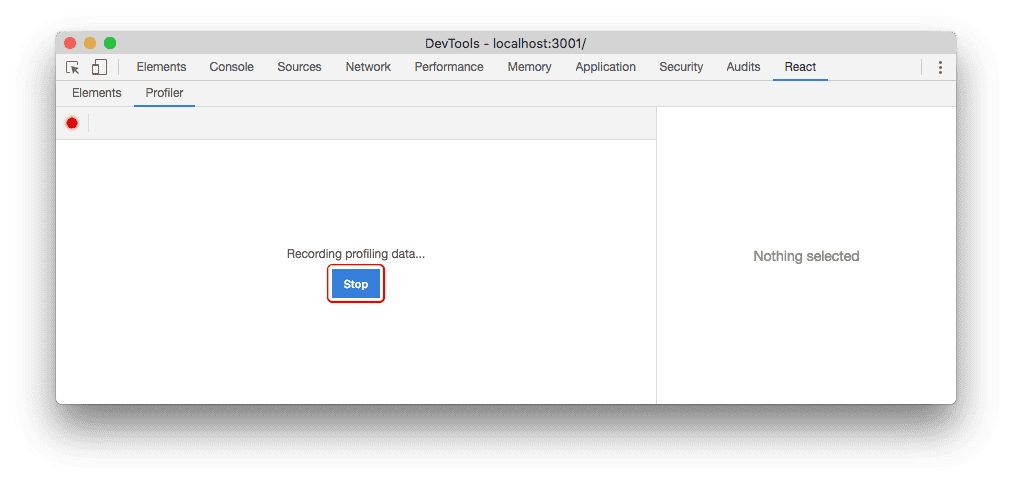React Profiler
React 16.5 添加了对开发者工具的 Profiler 插件的支持。该插件使用了 React 的 Profiler API 来收集所有组件渲染的耗时,目的是为了找出 React 应用程序的性能瓶颈。
这个“Profiler”面板初始为空,你可以点击 record 按钮开始分析:

当你开始记录之后,开发者工具将在每次应用程序渲染时自动收集性能数据。 你可以和平常一样使用你的应用程序, 当你完成分析之后,请点击“Stop”按钮。

优化法则
- 法则一:动静分离,将变的部分与不变的部分分离。
- 法则二:缓存,复杂计算和有昂贵消耗的组件 memo 化,比如 React 的 useMemo、useCallback,Redux 的 useSelector。
下面我们将根据这些法则结合实际开发中案例进行分析。
案例一
我们都知道,当 state 更新后,整个组件以及它的子组件都会重新更新,尽管子组件没有依赖任何 state,下面的例子就能很好地展示这个问题。
1
2
3
4
5
6
7
8
9
10
11
12
13
14
15
16
17
18
19
20
21
22
23
24
25
26
27
28
29
30
31
| import { useState } from 'react'
function Random() {
return <h1>{Math.random()}</h1>
}
function Count(props: { count: number}) {
return (
<h2>{props.count}</h2>
)
}
function App() {
const [count, setCount] = useState(0)
const onAdd = () => {
setCount(count + 1)
}
const onMinus = () => {
setCount(count - 1)
}
return (
<div className="App">
<Random />
<Count count={count}/>
<button onClick={onMinus}>➖</button>
<button onClick={onAdd}>➕</button>
</div>
);
}
export default App;
|
在以上示例中,我们声明了一个显示随机数的组件和一个依赖 count 状态的数字显示组件,使用 React Profiler 工具分析如下:

就像预期的那样,App、Count 和 Random 组件都更新了,从工具中我们可以看到它们更新的原因:
- App:Hook 1 changed.
- Count:Props changed(count).
- Random:The parent component rendered.
我们可以看到这里边除了 Count 是因为 count 更新之外,其他组件的更新都是被无辜牵连的。根据法则一,我们可以尝试将 Count 组件和它依赖的状态封装起来。
1
2
3
4
5
6
7
8
9
10
11
12
13
14
15
16
17
18
19
20
21
22
23
24
25
26
27
28
29
30
31
32
33
| import { useState } from 'react'
function Random() {
return <h1>{Math.random()}</h1>
}
function Count() {
const [count, setCount] = useState(0)
const onAdd = () => {
setCount(count + 1)
}
const onMinus = () => {
setCount(count - 1)
}
return (
<>
<h2>{count}</h2>
<button onClick={onMinus}>➖</button>
<button onClick={onAdd}>➕</button>
</>
)
}
function App() {
return (
<div className="App">
<Random />
<Count />
</div>
);
}
export default App;
|
从下图 Profiler 分析可以看到当 count 更新时,只有 Count 组件更新了。

上面的示例太过理想化,大部分时候,负责更新状态的组件和负责展示状态的组件可能并不在一起,也就没办法抽离动态组件。比如我们将示例中的组件位置做下调整:
1
2
3
4
5
6
7
8
9
10
11
|
function App() {
return (
<div className="App">
<Count count={count}/>
<Random />
<button onClick={onMinus}>➖</button>
<button onClick={onAdd}>➕</button>
</div>
);
}
|
这个时候,我们就需要法则二来帮助我们,最简单的是通过 props.children 属性来实现,原理上是一种依靠缓存的 bailout 优化方案。
1
2
3
4
5
6
7
8
9
10
11
12
13
14
15
16
17
18
19
20
21
22
23
24
25
26
27
28
29
30
31
32
33
34
35
36
37
38
39
| import React, { useState } from 'react'
interface CountProps {
children?: JSX.Element
}
function Random() {
return <h1>{Math.random()}</h1>
}
function Count(props: CountProps) {
const [count, setCount] = useState(0)
const onAdd = () => {
setCount(count + 1)
}
const onMinus = () => {
setCount(count - 1)
}
return (
<>
<h2>{count}</h2>
{props.children}
<button onClick={onMinus}>➖</button>
<button onClick={onAdd}>➕</button>
</>
)
}
function App() {
return (
<div className="App">
<Count>
<Random />
</Count>
</div>
);
}
export default App;
|
bailout
想要解释为什么案例一中使用 props.children 可以解决重复渲染,就要了解一下 React bailout 机制。
bailout(bail out of re-rendering)可以简单理解为是否重新渲染。
要触发 bailout 函数,需要同时满足以下条件:
- oldProps === newProps 并且 Context 没有改变
- !includesSomeLane(renderLanes, updateLanes)
当前 fiber 上是否存在更新,如果存在那么更新的优先级是否和本次整棵 Fiber 树调度的优先级一致?如果一致代表该组件上存在更新,需要走 render 逻辑。
1
2
3
4
5
6
7
8
9
10
11
12
13
14
15
|
if (current !== null) {
const oldProps = current.memoizedProps;
const newProps = workInProgress.pendingProps;
if (
oldProps !== newProps ||
hasLegacyContextChanged()
) {
didReceiveUpdate = true;
} else if (!includesSomeLane(renderLanes, updateLanes)) {
didReceiveUpdate = false;
return bailoutOnAlreadyFinishedWork(current, workInProgress, renderLanes);
}
}
|
bailout 函数逻辑大致是:尽量复用 fiber,不进行 render。fiber 复用,判断 fiber 的子树是否有 work。有,返回 child,继续遍历子树。无,返回 null,跳过子树。
1
2
3
4
5
6
7
8
9
10
11
12
13
14
15
16
17
18
19
20
21
|
function bailoutOnAlreadyFinishedWork(
current: Fiber | null,
workInProgress: Fiber,
renderLanes: Lanes,
): Fiber | null {
if (current !== null) {
workInProgress.dependencies = current.dependencies;
}
if (!includesSomeLane(renderLanes, workInProgress.childLanes)) {
return null;
}
cloneChildFibers(current, workInProgress);
return workInProgress.child;
}
|
案例一中,由于 children Random 组件的 props 没有发生改变,并且 lanes 也不在 renderLanes 上 ,Diff 组件命中 bailoutOnAlreadyFinishedWork。
lane 是 React 调度模型中的优先级模型。想象一下不同的赛车疾驰在不同的赛道。内圈的赛道总长度更短,外圈更长。某几个临近的赛道的长度可以看作差不多长。
lane 模型借鉴了同样的概念,使用 31 位的二进制表示 31 条赛道,位数越小的赛道优先级越高,某些相邻的赛道拥有相同优先级。
案例二
1
2
3
4
5
6
7
8
9
10
11
12
13
14
15
16
17
18
19
20
21
22
23
24
25
26
27
28
29
30
31
32
33
34
35
36
37
38
39
40
41
42
43
44
| import React, { useState, useContext } from 'react'
const countContext = React.createContext<number>(0);
const CountProvider = countContext.Provider;
function Random() {
return <h1>{Math.random()}</h1>
}
interface CountProps {
children?: JSX.Element
onAdd: () => void
onMinus: () => void
}
function Count(props: CountProps) {
const count = useContext(countContext);
return (
<>
<h2>{count}</h2>
<button onClick={props?.onMinus}>➖</button>
<button onClick={props?.onAdd}>➕</button>
</>
)
}
function App() {
const [count, setCount] = useState(0)
const onAdd = () => {
setCount(count + 1)
}
const onMinus = () => {
setCount(count - 1)
}
return (
<div className="App">
<CountProvider value={count}>
<Count onAdd={onAdd} onMinus={onMinus} />
<Random />
</CountProvider>
</div>
);
}
export default App;
|
该案例中我们引入了 Context,当 context 的 value 改变时,
参考链接










